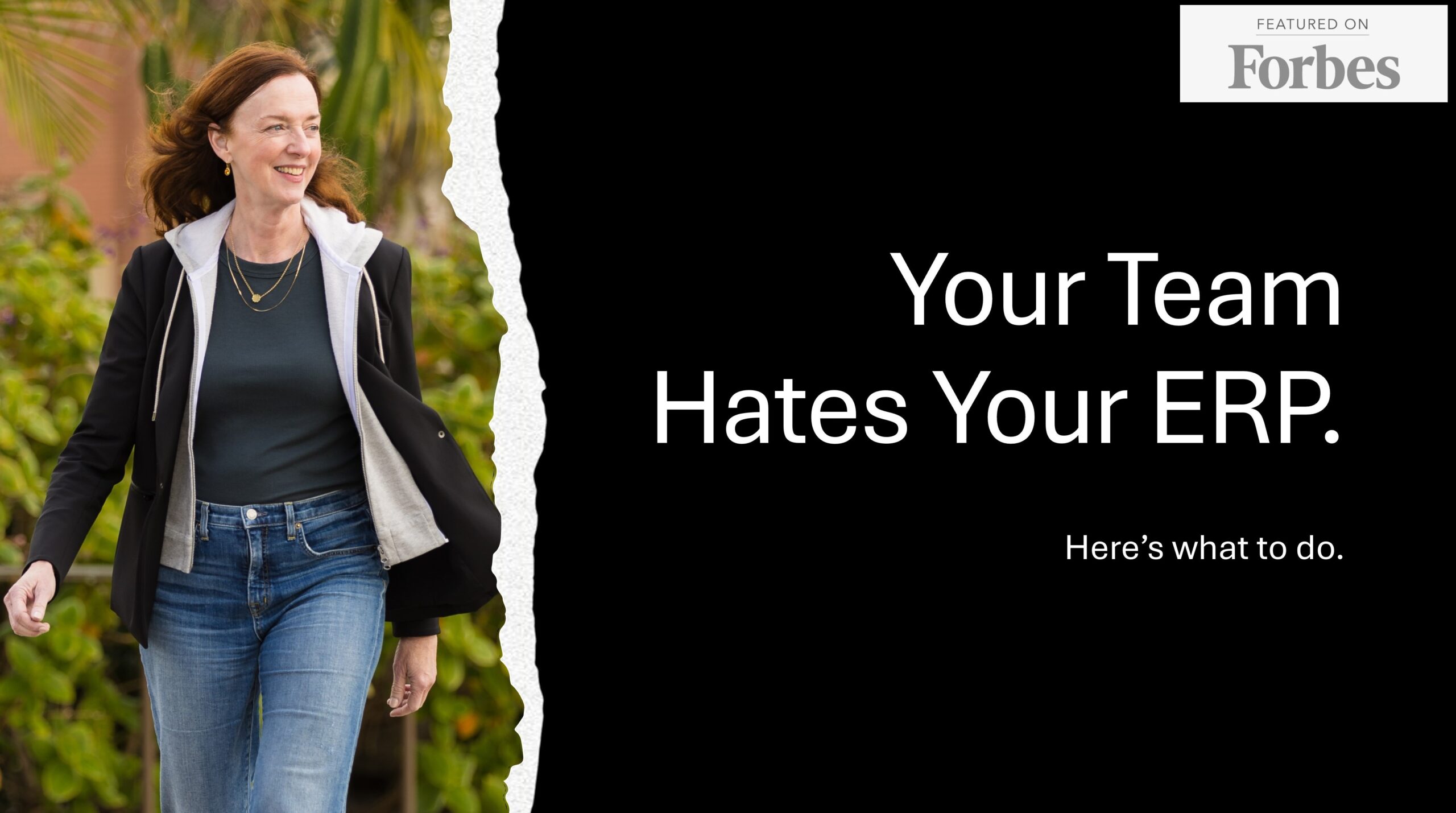
Enterprise Resource Planning. The software that touches every single part of your business takes, on average, 18.4 months and roughly 3-5% of your revenue to implement.
Companies make these big investments because ERP can deliver efficiency, productivity, visibility, better forecasting, and data security, all while reducing costs. In fact, many companies consider ERP essential to their future. Nem Fontanilla, who has spent 27 years enabling global transformations, recommends that organizations “Design the ERP with the vision in mind and leverage it to accelerate the achievement of your team’s vision, not to enable the current reality.”
Unfortunately, most companies experience a rough ride on the way to those benefits. A friend of mine is CEO of a midsized company, and is in the the second year of a promised six-month cutover. When he described the team’s difficulties closing the books due to the cutover, and the accounting teams increasing frustration, another friend chimed in. His team had a similar issue with their ERP implementation. He described their reaction as “organ rejection.”
Is your organization fighting off the ERP implementation? Here are some of the reasons.
“No time for that.” It’s more than enough to get the day-to-day work done. Adopting a new system demands attention and energy that equates to another full-time job.
“The best person for this project already has a job.” If you want the new system to work well, you need your best people on the ERP team – the folks who know your business best. So who is running day-to-day operations while they’re focused on your company’s future? The irony is that they’re so essential to the business that they can’t be spared, yet they’re probably worried they won’t have a job when the project ends. You have two obstacles to staffing your ERP team right.
“It’s good enough.” The old system and process works well enough. The team works on auto-pilot – they know what to input and where to send it. They find it hard to imagine the benefits of an operational overhaul outweighing the urgency of the moment. And frankly, some departments might be right about that. They might find the new system is worse for them even though it benefits the company as a whole.
Feeling a little defeated? You’re not alone. It’s chaotic enough to run a business. Now you’re intentionally introducing something that might break it.
Here’s what to do.
Embrace the suck. Assume employees will hate it. It’s a big change. Every living person is here because our ancestors were paranoid enough to anticipate danger and survive. Your new system is an intruder.
Resist cliché communications. Do not create a basic elevator speech. Do not create “talking head” videos of your executives saying how important this is. You will reinforce every cynical assumption your people have about this effort. Instead, create a consistent message frame that is customized by the speaker based on the audience. For more on how to communicate, go here.
Communicate based on impact. Employees care about when they will be affected and how. If you communicate too much, people tune out. You’re just teaching people to ignore you. For each person or team, communicate just what matters, just enough, and just in time.
Say the thing. There’s a natural tendency to hold back information that’s unpleasant or undefined. But fight that urge; the more more explicit you are, the more you dispel confusion and build trust. Spell out your scope and your timelines. If there will be layoffs, say so. Identify who is impacted and how.
Show them this time is different. Sometimes employees resist a change because they equate it to another change that “failed.” So highlight the differences between this project and others in the past. Differences might include:
- New Approach
- Different Team
- Different Budget
- Tighter or Expanded Scope
- Different Focus
- New Code
- Different Timing
Create fresh starts. A long ERP initiative can feel like a slog. Psychologically, we respond better to beginnings and ends. Seize on any arbitrary beginning that feels real: a new quarter, a new phase, hitting a milestone, or new metrics (like testing or training numbers). Help the team and the organization feel the progress and success by celebrating those starts and ends.
Focus on one small win. For each job role, think of only one thing an employee can do to use the new system, even if it’s as trival as logging in. Have them do it, and have them do it often. Make sure it’s easy, and that the experience is positive – for example, that the screen they’re on actually works. This gives them a sense that they can be successful and it makes the new system feel more familiar.
Double-down on From-To. Nem Fontanilla, who has spent 27 years in change and transformation, recommends that teams “(design) end-user readiness activities with (the user’s) day in the life in mind. Help them contextualize and see the change from their vantage point.” Where do your current fields appear in the new system? It’s that level of detail employees will want. Where is the data people used to use – where is it now? Document that, and train that. The more specific you are, the easier you make it for your people.
Prepare to invest in cutover twice. You’re working toward an end state. But in between here and there is a transition state. The support materials you develop differ for each state. You need temporary processes and training for employees who have the context of how they work now. These transition materials will be irrelevant once you complete the cutover. The second set, your steady state materials, are for new employees who have never known your old processes. They live on going forward. Some people try to skip the transition investment and only invest in the end state. However, that forces employees to figure it out on their own, which is a bit like interrupting a line of ants – they find a new path, but you have no way to control or predict it.
Nem Fontanilla says, “Turning on the ERP is the beginning…The functional teams need support to fully realize the value. It does not just happen because the new capabilities are available.”
Getting past the organ rejection takes focus and preparation, but it can be done. The huge investment in your ERP requires no less.




